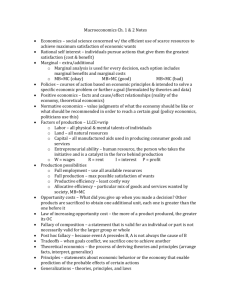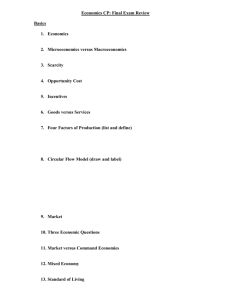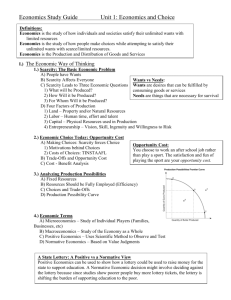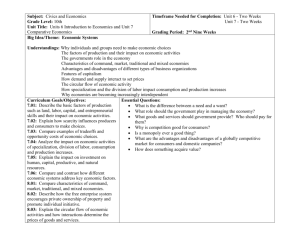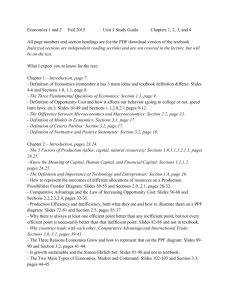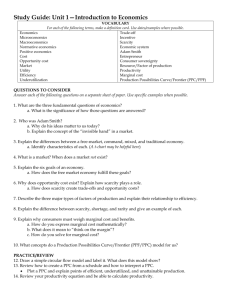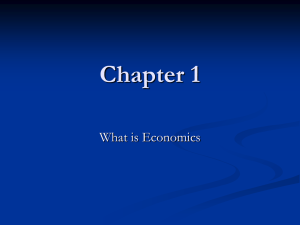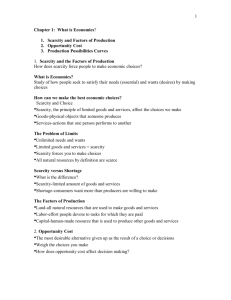Economics: Intro
advertisement
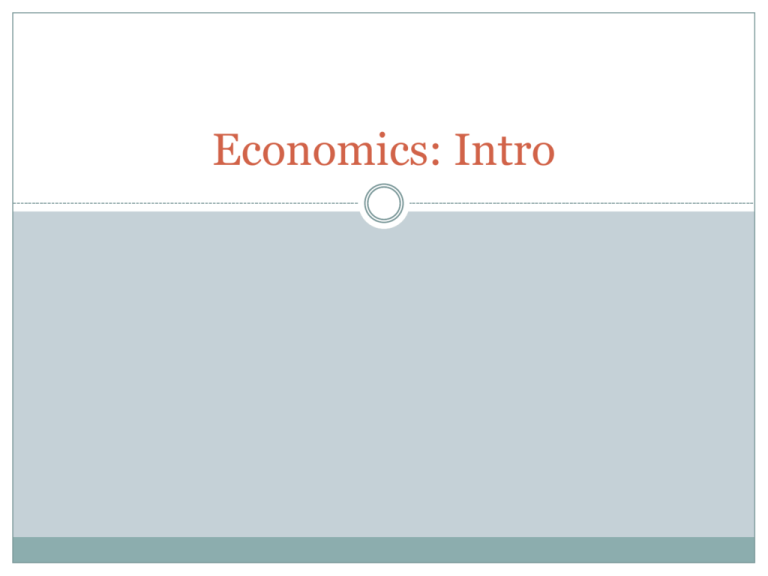
Economics: Intro Economics Economics is derived from the Greek word, oikonomos. Oikos – “house” Nomos – “management” What is required when people, firms, and government manage their resources? Decisions. Economics – The study of how economic agents allocate their limited resources to satisfy their unlimited wants. Economics "Economics is a social science that studies human behaviour as a relationship between ends and scarce means which have alternative uses. That is, economics is the study of the trade-offs involved when choosing between alternate sets of decisions.“ Lionel Robbins, 1935. Textbook definition - economics is study of how economic agents allocate their limited resources to satisfy their unlimited wants. Why do we have to make decisions? Scarcity – when unlimited wants exceed limited resources. Wants – Unfulfilled desires that motivate human behavior to use resources to quench biological and psychological desires that when satisfied improve human well-being. Resources – the inputs to produce outputs to meet human wants. They are also known as the factors of production. Resources Resources are also known as inputs or factors of production. (L) – Land – this includes physical land and natural resources (oil, fish stocks, nickel) (N) – Labor (K) – Capital Physical capital – machinery, buildings, equipment, new housing. Human capital – The skill set embodied in labor (E) – Entrepreneurship F.o.P = (L, N, K, E); These are the inputs required to make the goods and services that people value. Is a Car a Capital Good? A car can be both a final good (consumer good) or an input (capital good). When you drive around for personal use, a car is considered a consumer good. Suppose you use your car to deliver pizza, now your car is a piece of capital that is used in the production of home delivery for pizza. Three Key Economic Ideas 1. People are rational. People make choices because it is in their own self-interest. They do not make choices that leave them worse off. Economic agents weigh the benefits and costs of each action and choose an action only if the benefits outweigh the costs— even if it is not always the “best” decision. The economic definition of rationality does not necessarily mean “sane” or “level headed”. Three Key Economic Ideas 2. People respond to incentives. Why did you come to class or enroll at DMACC? Why didn’t banks take the FBI’s advice to install bulletresistant plastic windows for tellers and hire well trained armed guards to deter bank robberies? Why are there large underground economies in countries with corrupt governments? Why do M&M’s lead to better bladder control in young children? http://www.youtube.com/watch?v=W2hhIWbz0Ns Three Key Economic Ideas 3. Optimal decisions are made at the margin. While some decisions are all or nothing, many decisions are marginal. Marginal choices facing a consumer: What is the best use of the next hour of my time? How should I spend the $20 in my pocket? Marginal choices facing a firm: Should profits be used to hire another worker or upgrade capital? Should the firm stay open an hour later? Marginal choices facing a government: Should we add another freeway exit ramp? Optimal Decisions Optimal decisions – continue any activity up to the point where the MB = MC MB – marginal benefits MC – marginal costs Marginal analysis – comparing MB and MC. When you hear the word ‘marginal’, think additional, incremental, extra, or small change in. Three Basic Questions: What, How, and For Whom? Due to the problem of scarcity, every economy must answer the three basic questions: 1. What goods and services will be produced? 2. How will goods and services be produced? 3. Who will receive the goods and services produced? To answer these questions, society will organize themselves in two main ways; command and control economies and free markets. Command and Control / Centrally Planned Economics In Command and Control economies, government decrees economic activity and how resources will be allocated. Some problems inherent in centrally planned economies: Coordination – without market prices, central planners establish what gets produced. These economies often suffer shortages and surpluses. Incentives – There is often a lack of entrepreneurship in these economies due to a lack of profit incentive. Free Markets Free markets – decisions of resource allocation is made by the interaction of households and firms participating in markets, coordinated by a price system. No/Little government involvement. Complete individual control. Strong and well-defined property rights. Regulated by the invisible hand. Self-interest and competition promote efficiency and the best interest of society with no government involvement. Free Markets 1. What? Dictated by consumer sovereignty. 2. How? Determined by the least cost production technique achieved through competition. 3. For Whom? Goods and services will be distributed to consumers on the basis of their willingness and ability to pay. The “Virtues” of Free Markets Efficiency – Markets promote efficiency by allocating resources towards their highest valued use and promotes the least cost production technique. Incentives – Built in financial incentives for hard work, skill acquisition, and innovation. Freedom – Decision on how to allocate resources is based on voluntary consent rather than by decree of government. The Tale of Two Koreas After WW II, the Korean Peninsula was divided into North and South. North Korea South Korea GDP $40 billion $1.3 trillion GDP/capita $1,800 $27,700 Exports $2 billion $355 billion Imports $3.5 billion $313 billion Agriculture: % of GDP 23% 3% *2010 data Mixed Economy All economies are mixed economies, but vary in their degree of free markets and central planning. While markets are good at promoting efficiency, incentives, and freedom, equity matters to people and market failures occur. Markets may seem unfair when presenting opportunities to others since not everyone can provide “economic” value (elderly, disabled, young). Markets can fail in regards to monopolies, externalities, and provision of public goods. Positive vs. Normative Economics Positive Statements – Value free descriptions of and predictions about economic relationships. Positive statements do not have to be true, but can be checked for veracity with verifiable evidence. The unemployment rate is 25% is a positive statement, but not true. Address with “what is”. Positive vs. Normative Economics Normative Statements – Value-induced descriptions. These statements are not settled by evidence, but by persuasive rhetoric. Address “what ought to be”. Positive vs. Normative The government should increase the minimum wage to reduce poverty. Increasing the minimum wage by 10% will reduce the poverty rate by 3%. Economic Modeling An economic model is a simplified version of reality to help analyze real-word economics situations. The purpose of economic modeling is to understand, explain, and predict economic events. General steps to develop a model. 1. Decide on assumptions 2. Formulate testable hypothesis 3. Use data to test the hypothesis 4. Revise the model if it fails 5. Retain the model for future use Micro and Macroeconomics Microeconomics – the study of how households and firms makes choices, how they interact in markets, and how the government attempts to influence their choices. Macroeconomics – the study of the economy as a whole, including topics such as inflation, unemployment, and economic growth. Trade-Offs, Opportunity Cost, and PPF Due to the economic problem of scarcity, every decision requires a sacrifice or trade-off. What are the trade-offs households, firms, and governments are faced with rising health care costs? Opportunity Cost – The highest-valued alternative that must be given up to engage in any activity. Explains why TINSTAAFL. Trade-Offs, Opportunity Cost, and PPF Production Possibility Frontier (PPF) – a curve showing the maximum attainable combinations of two or more products that can be produced with given resources and technology during a given time period.
